Kerala Plus One Zoology Notes Chapter 3 Structural Organisation in Animals
What is a tissue?
In multicellular animals, a group of similar cells along with intercellular substances perform a specific function. Such an organization is called tissue.
ANIMAL TISSUES:
The tissues are different and are broadly classified into four types:
- Epithelial
- Connective
- Muscularand
- Neural.
Epithelial Tissue:
This tissues are found in the covering ora lining for some part of the body. The cells are compactly packed with little intercellular matrix.
There are two types of epithelial tissues namely:
- SIMPLE EPITHELIUM
- COMPOUND EPITHELIUM
1. Simple epithelium:
| It is composed of a single layer of cells and functions as a lining for body cavities, ducts, and tubes. The compound epithelium consists of two or more cell layers and has protective function as it does in our skin On the basis of structural modification of the cells, simple epithelium is further divided into three types. These are |
- Squamous
- Cuboidai
- Columnar
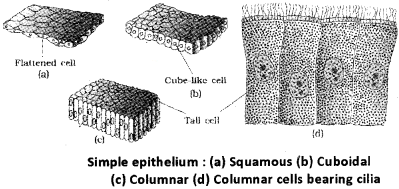
1. Squamous epithelium:
It forms single thin layer of flattened cells with irregular boundaries. They are found in the walls of blood vessels and air sacs of lungs and are involved in a functions like forming a diffusion boundary.
2. Cuboidai epithelium:
It is composed of a single layer of cube-like cells. This is commonly found in ducts of glands and tubular parts of nephrons in kidneys. Its main functions are secretion and absorption.
3. Columnar epithelium:
It is composed of a single layer of tall and slende cells. Their nuclei are located at the base. Free surface may have microvilli. They are found in the lining of stomach and intestine and help in secretion and absorption.
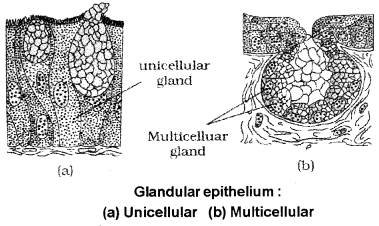
Ciliated epithelium:
If the columnar or cuboidai cells bear cilia on their free surface they are called ciliated epithelium Their function is to move particles or mucus in a specific direction overthe epithelium. They are present in bronchioles and fallopian tubes.
Glandular epithelium:
The modified columnar or cuboidal cells perform secretion and are called glandular epithelium.
They are mainly of two types:
- Unicellular (goblet cells of the alimentary canal)
- Multicellular(salivary gland).
On the basis of the mode of pouring of their secretions, glands are divided into two categories namely exocrine and endocrine glands.
Exocrine glands:
They secrete mucus, saliva, earwax, oil, milk, digestive enzymes and other cell products. These products are released through ducts or tubes.
Endocrine glands:
They do not have ducts. Their products called hormones are secreted directly into the blood.
2. Compound epithelium:
It is multi-layered of cells.
a. Their main function is to provide protection against chemical and mechanical stresses.
b. They cover the dry surface of the skin, the moist surface of buccal cavity, pharynx, inner lining of ducts of salivary glands and of pancreatic ducts.
Three types of cell junctions are found in the epithelium and other tissues. These are called as tight, adhering and gap junctions.
- Tight junctions help to stop substances from leaking across a tissue.
- Adhering junctions perform cementing to keep neighbouring cells together.
- Gap junctions facilitate the cells to communicate with each other by connecting the cytoplasm of adjoining cells for rapid transfer of ions and molecules.
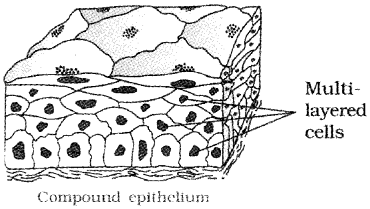
Connective Tissue:
Connective tissues helps to linking and supporting othertissues/organs of the body. They include
- cartilage
- bone
- adipose
- blood.
Collagen or elastin:
In all connective tissues except blood, the cells secrete fibres of structural proteins called collagen or elastin.
The fibres provide strength, elasticity and flexibility to the tissue.
These cells also secrete modified polysaccharides, which accumulate between cells and fibres and act as matrix (ground substance).
Connective tissues are classified into three types:
- Loose connective tissue
- Dense connective tissue and
- Specialised connective tissue
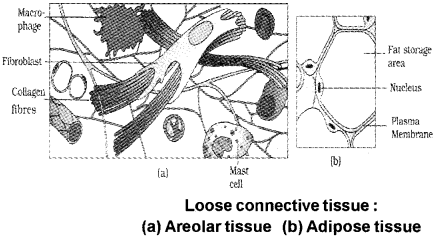
Loose connective tissue:
They are loosely arranged in a semi-fluid ground substance. For example,
Areolar tissue:
It is present beneath the skin. It contains fibroblasts (cells that produce and secrete fibres),macrophages and mast cells.
Adipose tissue:
It is the loose connective tissue located mainly beneath the skin. The cells of this tissue are specialised to store fats.
Dense connective tissues.
In this Fibres and fibroblasts are compactly packed and are called dense regular and dense irregular tissues. In the dense regular connective tissues, the collagen fibres are present injows between bundles of fibres.
eg:
- Tendons, which attach skeletal muscles to bones
- ligaments which attach one bone to another.
Dense irregular connective tissue has fibroblasts and many fibres (mostly collagen) that are present in the skin.

Specialized connective tissues: They are Cartilage, bones and blood.
Cartilage:
Cells of this tissue (chondrocytes) are enclosed in small cavities within the matrix. Most of the cartilages in vertebrate embryos are replaced by bones in adults. Cartilage is present in the tip of nose, outer ear joints, between adjacent bones of the vertebral column, limbs and hands in adults.
Bones:
They have a hard ground substance rich in calcium salts and collagen fibres which give bone its strength. Bones support and protect softer tissues and organs. The bone cells (osteocytes) are present in the spaces called lacunae.
Limb bones, such as the long bones of the legs, serve weight-bearing functions. They also interact with skeletal muscles attached to them to bring about movements. The bone marrow in some bones is the site of production of blood cells.
Blood:
It is a fluid connective tissue containing plasma, red blood cells (RBC), white blood cells (WBC) and platelets. It also helps in the transport of various substances.

Muscle Tissue:
It consists of long, cylindrical fibres arranged in parallel arrays. These fibres are composed of numerous fine fibrils, called myofibrils. Muscle fibres contract (shorten) in response to stimulation, then relax (lengthen) and in their uncontracted state. Muscles play an active role in all the movements of the body Muscles are of three types, skeletal, smooth, and cardiac.
1. Skeletal muscle:
It is the tissue is closely attached to skeletal bones. In a typical muscle such as the biceps, striated (striped) skeletal muscle fibres are bundled together in a parallel fashion.
2. Smooth muscle:
These fibres taper at both ends (fusiform) and do not show striations. The wall of internal organs such as the blood vessels, stomach and intestine contains this type of muscle tissue. Smooth muscles are ‘involuntary’ as their functioning cannot be directly controlled.
3. Cardiac muscle tissue:
It is a contractile tissue present only in the heart. Cell junctions fuse the plasma membranes of cardiac muscle cells and make them stick together In Communication when one cell receives a signal to contract, its neighbours are also stimulated to contract.

Neural Tissue:
Neurons, the unit of neural system are excitable cells The neuroglial cell which constitute the rest of the neural system protect and support neurons. Neuroglia make up more than one half the volume of neural tissue in our body.
Nerve impulse transmisssion:
When a neuron is suitably stimulated, an electrical disturbance is generated which swiftly travels along its plasma membrane and reaches at the neuron’s endings, or output zone, triggers events that may cause stimulation or inhibition of adjacent neurons and other cells.

ORGAN AND ORGAN SYSTEM:
Each organ in our body is made of one or more type of tissues. For example, our heart consists of all the four types of tissues, i.e., epithelial, connective, muscular and neural. In animals morphology refers to the external appearance of the organs or parts of the body.
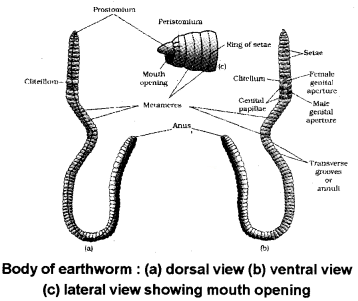
EARTHWORM:
Earthworm is a reddish brown terrestrial invertebrate The common Indian earthworms are Pheretima and Lumbricus.
Morphology:
They have long cylindrical body.lt is divided into more than hundred short segments which are similar. The dorsal surface of the body is marked by a dark median mid dorsal line (dorsal blood vessel). The ventral surface is distinguished by the presence of genital openings (pores).
Anterior end consists of the mouth and the prostomium, a lobe which serves as a covering for the mouth . The prostomium is sensory in function. The first body segment is called the peristomium (buccal segment) which conjoins the mouth.
In a mature worm, segments 14-16 are covered by a prominent dark band of glandular tissue called clitellum. Thus the body is divisible into three prominent regions.
- preclitellar
- clitellar &
- postclitellar segments
Four pairs of spermathecal apertures are situated 5th – 9th segments. A single female genital pore is present in the mid-ventral line of 14th segment. A pair of male genital pores are present on 18th segment.
Numerous minute pores called nephridiopores open on the surface of the body. In each body segment, except the first, last and clitellum, there are rows of S-shaped setae, Setae plays an important role is in locomotion.
Anatomy:
The body wall of the earthworm is covered externally by a thin non-cellular cuticle below which is the epidermis, two muscle layers and an innermost coelomic epithelium. The epidermis is made up of a single layer of columnar epithelial cells which contain secretory gland cells. A terminal mouth opens into the
- buccal cavity (1 – 3 segments) which leads into muscular pharynx.
- Oesophagus (5 – 7 segments), continues into a muscular gizzard (8 – 9 segments).
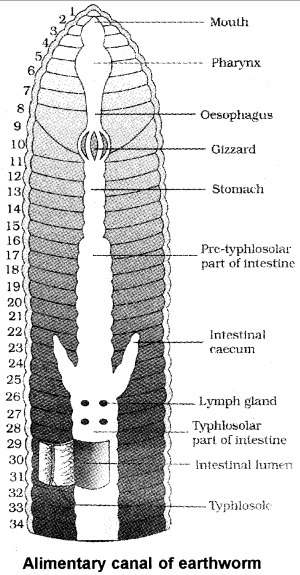
It helps in grinding the soil particles and decaying leaves etc. The stomach extends from 9 – 14 segments. The food of the earthworm is decaying leaves and organic matter mixed with soil. Calciferous glands, present in the stomach, neutralise the humic acid present in humus.
Intestine starts from the 15th segment onwards and continues till the last segment. A pair of short and conical intestinal caecae project from the intestine on the 26th segment. The characteristic feature of the intestine between 26 – 35 segments is the presence of internal median fold of dorsal wall called typhlosole.
This increases theeffective area of absorption in the intestine. The alimentary canal opens to the exterior by a small rounded aperture called anus. These simpler molecules are absorbed through intestinal membranes and are utilised. Pheretima shows closed type of blood vascular system, consisting of blood vessels, capillaries and heart.
Blood glands are present on the 4th, 5th and 6th segments. They produce blood cells and haemoglobin which is dissolved in blood plasma. Blood cells are phagocytic in nature.
In Earthworms respiratory exchange occurs through moist body surface into their blood stream. The excretory organs occur as segmentally arranged coiled tubules called nephridia They are of three types:
- septal nephridia, present on both the sides of intersegmental septa of segment 15 to the last that open into intestine,
- integumentary nephridia, attached to lining of the body wall of segment 3 to the last that open on the body surface and
- pharyngeal nephridia, present as three paired tufts in the 4th, 5th and 6th segments
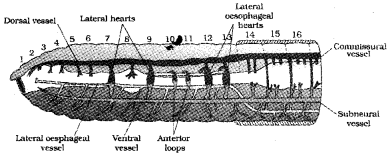
Nephridia:
It regulate the volume and composition of the body fluids. A nephridium starts out as a funnel that collects excess fluid from coelomic chamber. The funnel connects with a tubular part of the nephridium which delivers the wastes.
Nervous system:
It is represented by ganglia arranged segment wise on the ventral paired nerve cord (3rd and 4th segments). The cerebral ganglia along with other nerves in the ring integrate sensory input as well as command muscular responses of the body.
Sensory system does not have eyes but does possess light and touch sensitive organs to distinguish the light intensities and to fee the vibrations in the ground. Worms have specialised chemoreceptors (taste receptors) which react to chemical stimuli. Earthworm is hermaphrodite (bisexual), i.e., testes and ovaries are present in the same individual.
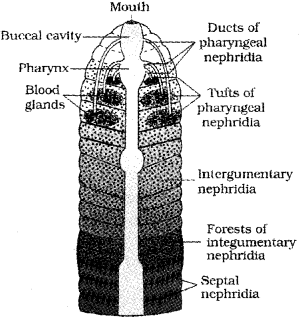
There are two pairs of testes present in the 10th and 11th segments. Their vasa deferentia run up to the 18th segment where they join the prostatic duct. Two pairs of accessory glands are present one pair each in the 17th and 19th segments. The common prostrate and spermatic duct opens to the exterior by a pair of male genital pores on the ventro-lateral side of the 18th segment.
Four pairs of spermathecae are located in 6th – 9th segments (one pair in each segment).They receive and store spermatozoa during copulation. One pair of ovaries is attached at the 12th and 13th segments. Ovarian funnels are present beneath the ovaries which continue into oviduct, join together and open on the ventral side as a single median female genital pore on the 14th segment.
A mutual exchange of sperm occurs between two worms during mating. Mature sperm and egg cells and nutritive fluid are deposited in cocoons produced by the gland cells of clitellum.

Fertilisation:
Fertilisation and development occur within the cocoons which are deposited in soil. The ova (eggs) are fertilised by the sperm cells within the cocoon. The cocoon holds the worm embryos. After about 3 weeks, each cocoon produces two to twenty baby worms. Earthworms development is direct, i.e., there is no larva formed.
Earthworms are known as ‘friends of farmers’ because they make burrows in the soil and make it porous which helps in respiration and penetration of the developing plant roots. The process of increasing fertility of soil by the earthworms is called vermicomposting. They are also used as bait in game fishing
COCKROACH:
Cockroaches are are included in class Insecta of Phylum Arthropoda. They are nocturnal omnivores that live in damp places throughout the world. They are found in human homes and thus are serious pests and vectors of several diseases.
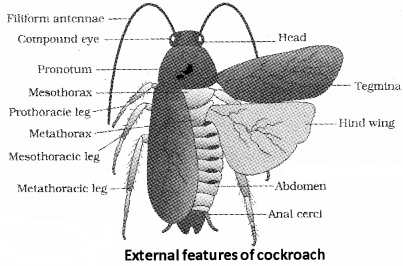
Morphology:
The adults of the common species of cockroach, Periplaneta americana are about 34 – 53 mm long with wings that extend beyond the tip of the abdomen in males. The body of the cockroach is segmented and divisible into three distinct regions – head, thorax and abdomen. The body is covered by a hard chitinous exoskeleton.
Exoskeleton has hardened plates called sclerites that are joined to each other by a thin and flexible articular membrane (arthrodial membrane). Head is formed by the fusion of six segments and shows great mobility in all directions due to flexible neck It has compound eyes. A pair of antennae arise from sockets lying in front of eyes. They help in monitoring the environment.
Anterior end of the head bears appendages forming biting and chewing type of mouth parts. It consists of a labrum (upper lip), pair of mandibles, a pair of maxillae and a labium (lower lip). A median flexible lobe, acting as tongue (hypopharynx), lies within the cavity enclosed by the outhparts.
Thorax consists of three parts:
- prothorax
- mesothorax
- metathorax.
Each thoracic segment bears a pair of walking legs. The first pair of wings arises from mesothorax and the second pair from metathorax. Forewings (mesothoracic) called tegmina are opaque dark and leathery and cover the hind wings when at rest. The hind wings are transparent, membranous and are used in flight.
The abdomen in both males and females consists of 10 segments. In females, the 7th sternum is boat shaped and together with the 8th and 9th sterna forms a genital pouch whose anterior part contains female gonopore, spermathecal pores and collateral glands.
In males, genital pouch lies at the hind end of abdomen bounded dorsally by 9th and 10th terga and ventrally by the 9th sternum. It contains dorsal anus, ventral male genital pore and gonapophysis. Males bear a pair of short, threadlike anal styles which are absent in females. In both sexes, the 10th segment bears a pair of jointed filamentous structures called anal cerci.

Anatomy:
The alimentary canal is divided into three regions: foregut, midgut and hindgut The mouth opens into a short tubular pharynx, leading to a narrow tubular passage called oesophagus.
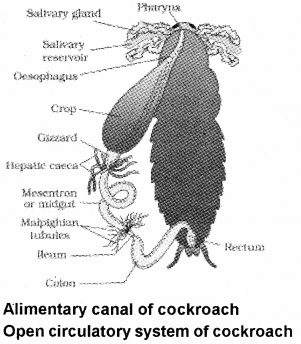
Oesophagus opens into a sac like structure called crop used for storing of food. The crop is followed by gizzard or proventriculus. Gizzard helps in grinding the food particles. A ring of 6 – 8 blind tubules called hepatic or gastric caecae is present at the junction of foregut and midgut, which secrete digestive juice.
At the junction of midgut and hindgut is present another ring of 100 – 150 yellow coloured thin filamentous Malphigian tubules. They help in removal of excretory products from haemolymph. The hindgut is differentiated into ileum, colon and rectum. The rectum opens out through anus.
Blood vascular system of cockroach is an open type Blood vessels are open into space (haemocoel). Visceral organs located in the haemocoel are bathed in blood (haemolymph).The haemolymph is composed of colourless plasma and haemocytes.
Heart of cockroach consists of elongated muscular tube lying along mid dorsal line of thorax and abdomen. Blood from sinuses enter heart through ostia and is pumped anteriorly to sinuses again. The respiratory system consists of a network of trachea, that open through 10 pairs of small holes called spiracles present on the lateral side of the body.
Thin branching tubes carry oxygen from the airto all the parts. Exchange of gases take place at the tracheoles by diffusion. During excretion Malpighian tubules absorb nitrogenous waste products and convert them into uric acid which is excreted out through the hindgut. Therefore, this insect is called uricotelic.
In addition, the fat body, nephrocytes and urecose glands also help in excretion. The nervous system of cockroach consists of segmentally arranged ganglia joined by paired longitudinal connectives. Three ganglia lie in the thorax, and six in the abdomen.
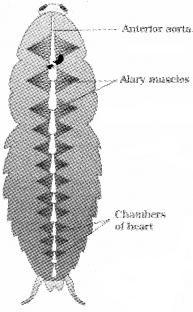

The nervous system of cockroach is spread throughout the body. If the head of a cockroach is cut off, it will still live for as long as one week. In the head region, the brain is represented by supra-oesophageal ganglion which supplies nerves to antennae and compound eyes. In cockroach, the sense organs are antennae, eyes, maxillary palps, larfial palps, anal cerci, etc.
Compound eves of cockroach:
The compound eyes are situated at the dorsal surface of the head. Each eye consists of about 2000 hexagonal ommatidia. With the help of several ommatidia, a cockroach can receive several images of an object. This kind of vision is known as mosaic vision with more sensitivity but less resolution, being common during night (hence called nocturnal vision).
Cockroaches are dioecious Male reproductive system consists of a pair of testes lying one on each lateral side in the 4th – 6th abdominal segments. From each testis arises a thin vas deferens, which opens into ejaculatory duct through seminal vesicle. The ejaculatory duct opens into male gonopore situated ventral to anus.
A characteristic mushroom shaped gland is present in the 6th – 7th abdominal segments which functions as an accessory reproductive gland. The external genitalia are represented by male gonapophysis or phallomere The sperms are stored in the seminal vesicles and are glued together in the form of bundles called spermatophores which are discharged during copulation.
The female reproductive sysytem consists of two large ovaries, lying laterally in the 2nd – 6th abdominal segments. Each ovary is formed of a group of eight ovarian tubules or ovarioles, containing a chain of developing ova. Oviducts of each ovary unite into a single median oviduct (also called vagina) which opens into the genital chamber.
Sperms are transferred through spermatophores. Their fertilised eggs are stored in capsules called oothecae. On an average, females produce 9 – 10 oothecae, each containing 14 – 16 eggs. The development of P. Americana is paurometabolous, meaning there is development through nymphal stage.
The nymph grows by moulting about 13 times to reach the adult form. The next to last nymphal stage haswing pads but only adult cockroaches have wings.
FROGS:
Frogs are belong to class Amphibia of phylum Chordata. The most common species of frog found in India is Rana tigrina. Their body temperature varies with the temperature of the environment. Such animals are called cold blooded or poikilotherms They have the ability to change the colour to hide them from their enemies (camouflage).
This protective coloration is called mimicry. During peak summer and winterthey take shelter in deep burrows to protect them from extreme heat and cold. This is called as summer sleep (aestivation) and wintersleep (hibernation).
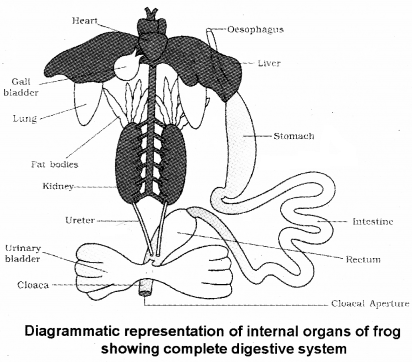
Morphology:
The skin is maintained in a moist condition. The frog never drinks water but absorb it through the skin. Body of a frog is divisible into head and trunk. A neck and tail are absent. Above the mouth, a pair of nostrils is present. Eyes are bulged and covered by a nictitating membrane that protects them while in water.
On either side of eyes a membranous tympanum (ear) receives sound signals. The forelimbs and hind limbs help in swimming, walking, leaping and burrowing. The hind limbs end in five digits and they are larger and muscular than fore limbs that end in four digits.
Feet have webbed digits that help in swimming. Frogs exhibit sexual dimorphism. Male frogs can be distinguished by the presence of sound producing vocal sacs and also a copulatory pad on the first digit of the fore limbs which are absent in female frogs.
Anatomy:
The body cavity consists of organ systems such as digestive, circulatory, respiratory, nervous, excretory and reproductive systems. The digestive system consists of alimentary canal and digestive glands. The alimentary canal is short because frogs are carnivores and hence the length of intestine is reduced.
The mouth opens into the buccal cavity that leads to the oesophagus through pharynx. Oesophagus is a short tube that opens into the stomach which in turn continues as the intestine,rectum and finally opens outside by the cloaca. Liver secretes bile that is stored in the gall bladder. Pancreas, a digestive gland produces pancreatic juice containing digestive enzymes.
Digestion of food takes place by the action of HCI and gastric juices secreted from the walls of the stomach. Partiailv digested food called chyme is passed from stomach to the first part of the intestine, the duodenum. The duodenum receives bile from gall bladder and pancreaticjuicesfrom the pancreas through a common bile duct.
Bile emulsifies fat and pancreatic juices digest carbohydrates and proteins. Final digestion takes place in the intestine. Digested food is absorbed by the numerous finger-like folds in the inner wall of intestine called villi and microvilli. The undigested solid waste moves into the rectum and passes out through cloaca.
In water, skin acts as aquatic respiratory organ (cutaneous respiration). Dissolved oxygen in the water is exchanged through the skin by diffusion. On land, the buccal cavity, skin and lungs act as the respiratory organs. The respiration by lungs is called pulmonary respiration.
The lungs are a pair of elongated, pink coloured sac- like structures present in the upper part of the trunk region (thorax). Air enters through the nostrils into the buccal cavity and then to lungs. During aestivation and hibernation gaseous exchange takes place through skin. The blood vascular system involves heart, blood vessels and blood.
The lymphatic system consists of lymph, lymph channels and lymph nodes. Heart is a muscular structure situated in the upper part of the body cavity. It has three chambers, two atria and one ventricle and is covered by a membrane called pericardium. Atriangularstructure called sinus venosus joins the right atrium.
It receives blood through the major veins called vena cava. The ventricle opens into a saclike conus arteriosus on the ventral side of the heart. The blood from the heart is carried to all parts of the body by the arteries (arterial system).The veins collect blood from different parts of body to the heart and form the venous system.
Special venous connection between liver and intestine as well as the kidney and lower parts of the body are present in frogs. The former is called hepatic portal system and the latter is called renal portal system.
The blood is composed of plasma and cells. The blood cells are RBC (red blood cells) or erythrocytes, WBC (white blood cells) or leucocytes and platelets. RBC’s are nucleated and contain red coloured pigment namely haemoglobin. The lymph is different from blood. It lacks few proteins and RBCs.
The excretory system consists of a pair of kidneys, ureters, cloaca and urinary bladder. Each kidney is composed of several structural and functional units called uriniferous tubules or nephrons. Two ureters emerge from the kidneys in the male frogs. The ureters act as urinogenital duct which opens into the cloaca.
In females the ureters and oviduct open seperately in the cloaca. The thin-walled urinary bladder is present ventral to the rectum which also opens in the cloaca. The frog excretes urea and thus is a ureotelic animal.
The chemical coordination of various organs of the body is achieved by hormones which are secreted by the endocrine glands. The endocrine glands found in frog are pituitary, thyroid, parathyroid, thymus, pineal body, pancreatic islets, adrenals and gonads.
The nervous system is organized into a central nervous system (brain and spinal cord), a peripheral nervous system (cranial and spinal nerves) and an autonomic nervous system (sympathetic and parasympathetic). There are ten pairs of cranial nerves arising from the brain. Brain is enclosed in a bony structure called brain box(cranium).
The brain is divided into fore-brain, mid-brain and hind-brain. Forebrain includes olfactory lobes, paired cerebral hemispheres and unpaired diencephalon. The midbrain is characterised by a pair of optic lobes. Hind-brain consists of cerebellum and medulla oblongata.
The medulla oblongata passes out through the foramen magnum and continues into spinal cord, which is enclosed in the vertebral column. Frog has different types of sense organs, namely organs of touch (sensory papillae), taste (taste buds), smell (nasal epithelium), vision (eyes) and hearing (tympanum with internal ears).
Eyes in a frog are a pair of spherical structures situated in the orbit in skull. External ear is absent in frogs and only tympanum can be seen externally. The ear is an organ of hearing as well as balancing (equilibrium).
Male reproductive organs consist of a pair of yellowish ovoid testes which are found adhered to the upper part of kidneys by a double fold of peritoneum called mesorchium. Vasa efferentia are 10 – 12 in number that arise from testes. They enter the kidneys on their side and open into Bidder’s canal.
Finally it communicates with the urinogenital duct that comes out of the kidneys and opens into the cloaca. The cloaca is a small, median chamber that is used to pass faecal matter, urine and sperms to the exterior.
The female reproductive organs include a pair of ovaries. They are situated near kidneys and there is no functional connection with kidneys. A pair of oviduct arising from the ovaries opens into the cloaca separately. A mature female can lay 2500 to 3000 ova at a time.
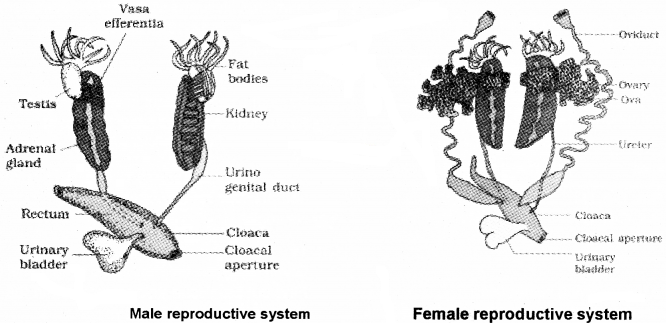
Fertilisation is external and takes place in Water. Development involves a larval stage called tadpole. Tadpole undergoes metamorphosis to form the adult. Frogs are beneficial for mankind because they eat insects and protect the crop.
Frogs maintain ecological balance because these serve as an important link of food chain and foodweb in the ecosystem. In some countries the muscular legs of frog are used as food by man.
